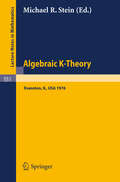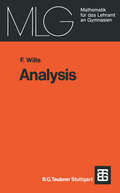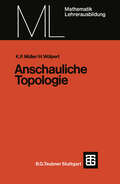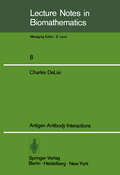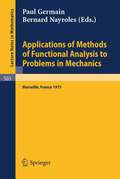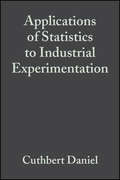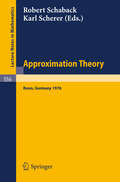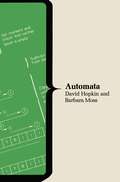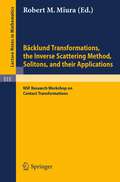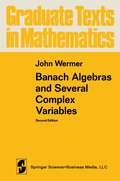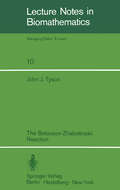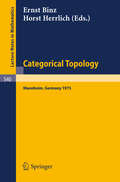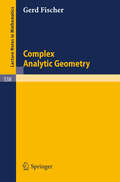- Table View
- List View
Advances in Complex Function Theory: Proceedings of Seminars held at Maryland, University, 1973/74. (Lecture Notes in Mathematics #505)
by W. E. Kirwan L. ZalcmanAlgebra (Undergraduate Texts in Mathematics)
by L.E. SiglerThere is no one best way for an undergraduate student to learn elementary algebra. Some kinds of presentations will please some learners and will disenchant others. This text presents elementary algebra organized accord ing to some principles of universal algebra. Many students find such a presentation of algebra appealing and easier to comprehend. The approach emphasizes the similarities and common concepts of the many algebraic structures. Such an approach to learning algebra must necessarily have its formal aspects, but we have tried in this presentation not to make abstraction a goal in itself. We have made great efforts to render the algebraic concepts intuitive and understandable. We have not hesitated to deviate from the form of the text when we feel it advisable for the learner. Often the presenta tions are concrete and may be regarded by some as out of fashion. How to present a particular topic is a subjective one dictated by the author's estima tion of what the student can best handle at this level. We do strive for consistent unifying terminology and notation. This means abandoning terms peculiar to one branch of algebra when there is available a more general term applicable to all of algebra. We hope that this text is readable by the student as well as the instructor. It is a goal of ours to free the instructor for more creative endeavors than reading the text to the students.
Algebra II Ring Theory: Vol. 2: Ring Theory (Grundlehren der mathematischen Wissenschaften #191)
by Carl FaithAlgebraic K-Theory: Papers presented at the Conference held at Northwestern University, Evanston, January 12-16, 1976 (Lecture Notes in Mathematics #551)
by Michael R. SteinAlgebraic Theories (Graduate Texts in Mathematics #26)
by E.G. ManesIn the past decade, category theory has widened its scope and now inter acts with many areas of mathematics. This book develops some of the interactions between universal algebra and category theory as well as some of the resulting applications. We begin with an exposition of equationally defineable classes from the point of view of "algebraic theories," but without the use of category theory. This serves to motivate the general treatment of algebraic theories in a category, which is the central concern of the book. (No category theory is presumed; rather, an independent treatment is provided by the second chap ter.) Applications abound throughout the text and exercises and in the final chapter in which we pursue problems originating in topological dynamics and in automata theory. This book is a natural outgrowth of the ideas of a small group of mathe maticians, many of whom were in residence at the Forschungsinstitut für Mathematik of the Eidgenössische Technische Hochschule in Zürich, Switzerland during the academic year 1966-67. It was in this stimulating atmosphere that the author wrote his doctoral dissertation. The "Zürich School," then, was Michael Barr, Jon Beck, John Gray, Bill Lawvere, Fred Linton, and Myles Tierney (who were there) and (at least) Harry Appelgate, Sammy Eilenberg, John Isbell, and Saunders Mac Lane (whose spiritual presence was tangible.) I am grateful to the National Science Foundation who provided support, under grants GJ 35759 and OCR 72-03733 A01, while I wrote this book.
Analysis: Eine anwendungsbezogene Einführung (Mathematik für das Lehramt an Gymnasien)
by Friedrich WilleDer Studierende des Faches Mathematik steht häufig vor dem Problem: Wozu sind die mathematischen Begriffe, Sätze und Denkweisen gut, die in großer Vielzahl auf ihn ein stürmen? Wozu werden die Ergebnisse gebraucht, flir welche weiteren überlegungen sind sie wiederum Grundlage und Ausgangspunkt? Die vorliegende Einführung in die Analysis hat zum Ziel, dem Leser bei diesen Frage stellungen zu helfen, ihm Beweggründe flir die wichtigsten Grundbegriffe, Ansätze und Ziele der Differential- und Integralrechnung zu vermitteln. Als Schlüsselproblem erweist sich dabei die Frage nach den Lösungen von Gleichungen und Gleichungssystemen. Hiervon ausgehend werden Abbildungsbegriff, Konvergenzbe griff (Iteration), Stetigkeit (Lösungsexistenz ), Differenzierbarkeit (Newton-Verfahren) und vieles mehr erschlossen. Andere Inhalte wurzeln auf natürliche Weise in geometri schen Fragestellungen, wie die Integralrechnung (Flächeninhaltsberechnung) und die trigonometrischen Funktionen (Entfernungsbestimmung). Der Leser erhält damit eine Richtschnur in die Hand, mit der sich die Differential- und Integralrechnung überschau bar gliedert. Bei der Stoffauswahl wurden Inhalte bevorzugt, die einerseits breiten Anwendungsbezug haben, andererseits vorbereitend zu Begriffsbildungen der höheren Analysis hinführen, insbesondere zur Funktionalanalysis, wie z. B. der Banachsche Fixpunktsatz, der Bor suksche Antipodensatz, der Brouwersche Fixpunktsatz, das Newton-Verfahren für mehrere Veränderliche und anderes mehr. Die numerischen Verfahren, die in diesem Buch behandelt werden, lassen sich bequem auf Kleinrechnern durchführen, wie sie heute in der Schule vielfach verwendet werden. Schließlich sei erwähnt, daß bei der Einführung der Konvergenz wie auch der Stetigkeit ein neuer Weg beschritten wird.
Anschauliche Topologie: Eine Einführung die elementare Topologie und Graphentheorie (Mathematik für die Lehrerausbildung)
by Kurt Peter Müller Heinrich WölpertAntigen Antibody Interactions (Lecture Notes in Biomathematics #8)
by C. Delisi1. 1 Organization of the Immune System One of the most important survival mechanisms of vertebrates is their ability to recognize and respond to the onslaught of pathogenic microbes to which they are conti- ously exposed. The collection of host cells and molecules involved in this recognition 12 response function constitutes its immune system. In man, it comprises about 10 cells 20 (lymphocytes) and 10 molecules (immunoglobulins). Its ontogenic development is c- strained by the requirement that it be capable of responding to an almost limitless variety of molecular configurations on foreign substances, while simultaneously remaining inert to those on self components. It has thus evolved to discriminate, with exquisite precision, between molecular patterns. The foreign substances which induce a response, called antigens, are typically large molecules such as proteins and polysaccharides. The portions of these with which immunoglobulins interact are called epitopes or determinants. A typical protein epitope may consist of a configuration formed by the spatial arrangements of four or five amino acids and have an average linear dimension of about 20 A.
Applications of Methods of Functional Analysis to Problems in Mechanics: Joint Symposium IUTAM/IMU held in Marseille, Sept. 1-6, 1975 (Lecture Notes in Mathematics #503)
by P. Germain B. NayrolesApplications of Statistics to Industrial Experimentation (Wiley Series in Probability and Statistics #27)
by Cuthbert DanielOther volumes in the Wiley Series in Probability and MathematicalStatistics, Ralph A. Bradley, J. Stuart Hunter, David G. Kendall,& Geoffrey S. Watson, Advisory Editors Statistical Models inApplied Science Karl V. Bury Of direct interest to engineers andapplied scientists, this book presents general principles ofstatistics and specific distribution methods and models. Prominentdistribution properties and methods that are useful over a widerange of applications are covered in detail. The strengths andweaknesses of the distributional models are fully described, givingthe reader a firm, intuitive approach to the selection of the modelmost appropriate to the problem at hand. 1975 656 pp. FittingEquations To Data Computer Analysis of Multifactor Data forScientists and Engineers Cuthbert Daniel & Fred S. Wood Withthe assistance of John W. Gorman The purpose of this book is tohelp the serious data analyst, scientist, or engineer with acomputer to: recognize the strengths and limitations of his data;test the assumptions implicit in the least squares methods used tofit the data; select appropriate forms of the variables; judgewhich combinations of variables are most influential; and state theconditions under which the fitted equations are applicable.Throughout, mathematics is kept at the level of college algebra.1971 342 pp. Methods for Statistical Analysis of Reliability AndLife Data Nancy R. Mann, Ray E. Schafer & Nozer D. SingpurwallaThis book introduces failure models commonly used in reliabilityanalysis, and presents the most useful methods for analyzing thelife data of these models. Highlights include: material onaccelerated life testing; a comprehensive treatment of estimationand hypothesis testing; a critical survey of methods forsystem-reliability confidence bonds; and methods for simulation oflife data and for testing fit. 1974 564 pp.
Approximation Theory: Proceedings of an International Conference held at Bonn, Germany, June 8-11, 1976 (Lecture Notes in Mathematics #556)
by R. Schaback K. SchererBäcklund Transformations, the Inverse Scattering Method, Solitons, and Their Applications: Proceedings of the NSF Research Workshop on Contact Transformations, held in Nashville, Tennessee, 1974 (Lecture Notes in Mathematics #515)
by Robert M. MiuraProceedings of the NSF Research Workshop on Contact Transformations, Held in Nashville, Tennessee, 1974
Banach Algebras and Several Complex Variables (Graduate Texts in Mathematics #35)
by John WermerDuring the past twenty years many connections have been found between the theory of analytic functions of one or more complex variables and the study of commutative Banach algebras. On the one hand, function theory has been used to answer algebraic questions such as the question of the existence of idempotents in a Banach algebra. On the other hand, concepts arising from the study of Banach algebras such as the maximal ideal space, the Silov boundary, Gleason parts, etc. have led to new questions and to new methods of proof in function theory. Roughly one third of this book isconcerned with developing some of the principal applications of function theory in several complex variables to Banach algebras. We presuppose no knowledge of severalcomplex variables on the part of the reader but develop the necessary material from scratch. The remainder of the book deals with problems of uniform approximation on compact subsets of the space of n complex variables. For n > I no complete theory exists but many important particular problems have been solved. Throughout, our aim has been to make the exposition elementary and self-contained. We have cheerfully sacrificed generality and completeness all along the way in order to make it easier to understand the main ideas.
The Belousov-Zhabotinskii Reaction (Lecture Notes in Biomathematics #10)
by J.J. TysonIn 1958 B. P. Belousov discovered that the oxidation of citric acid by bromate in the presence of cerium ions does not proceed to equilibrium methodically and uniformly, like most chemical reactions, but rather oscillates with clocklike precision between a yellow and colorless state. See Fig. 11. 1, p. 30. A. M. Zhabotinskii followed up on Belousov's original observation and in 1964 his first investigations appeared in the Russian journal Biofizika. Though H. Degn (in Copenhagen at the time) knew of Zhabotinskii's work and published his own account of the mechanism of oscillation in Nature (1967), this interesting reaction attracted little attention among Western scientists until 1968, when Zhabotinskii and his coworkers and Busse (from Braunschweig, W. Germany) reported on their work at an international conference on biological and biochemical oscillators held in Prague. Shortly thereafter appeared· a flurry of papers on temporal oscillations and spatial patterns in this reaction system. Vavilin and Zhabotinskii (1969) [and later Kasperek and Bruice (1971)] studied the kinetics of the oxidation 3 of Ce+ by Br0 and the oxidation of organic species by Ce+4. Busse (1969) 3 reported his observation of colored bands of chemical activity propagating up and down in a long tube of unstirred solution. Zaikin and Zhabotinskii (1970) observed circular chemical waves in thin layers of solution.
Biomathematik für Mediziner: Begleittext zum Gegenstandskatalog (Heidelberger Taschenbücher #164)
by Kollegium Biomathematik Kollegium Biomathe NwBoundary Theory for Symmetric Markov Processes (Lecture Notes in Mathematics #516)
by M.L. SilversteinBrauer Groups: Proceedings of the Conference held at Evanston, October 11-15, 1975 (Lecture Notes in Mathematics #549)
by D. Zelinskya




